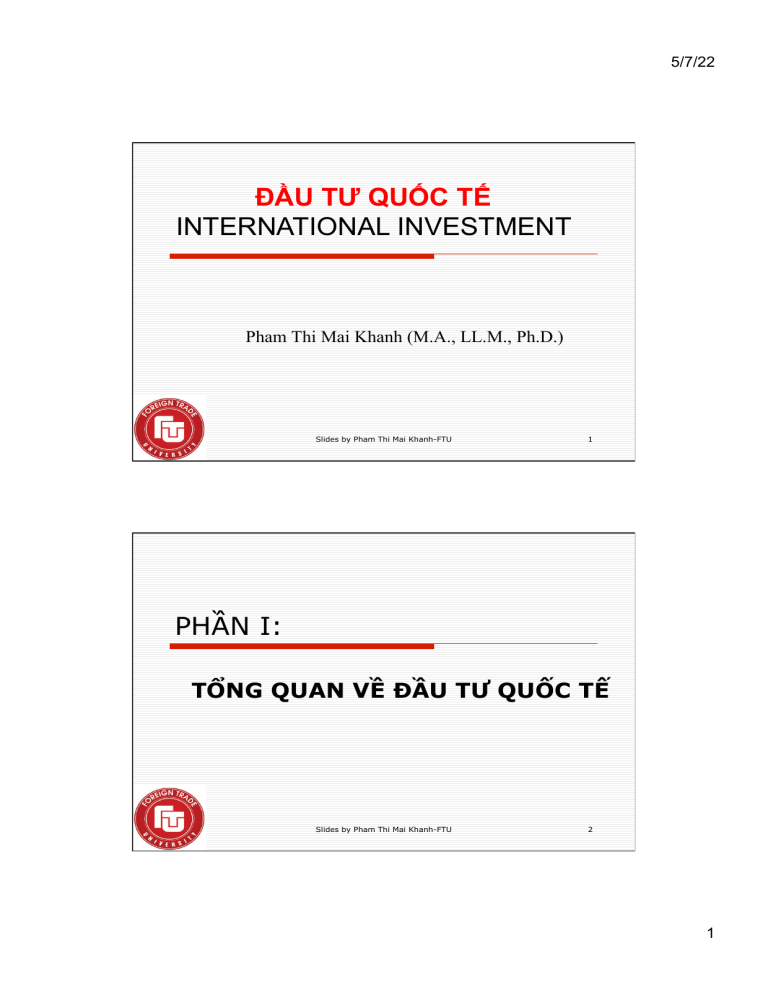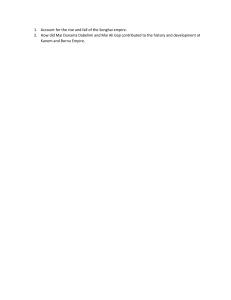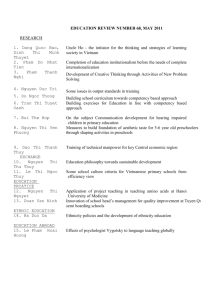
5/7/22 ĐẦU TƯ QUỐC TẾ INTERNATIONAL INVESTMENT Pham Thi Mai Khanh (M.A., LL.M., Ph.D.) Slides by Pham Thi Mai Khanh-FTU 1 PHẦN I: TỔNG QUAN VỀ ĐẦU TƯ QUỐC TẾ Slides by Pham Thi Mai Khanh-FTU 2 1 5/7/22 NỘI DUNG I. Khái niệm, đặc điểm của Đầu tư, Đầu tư nướ ngoài và Đầu tư quốc tế II. Phân loại các luồng tài chính quốc tế Slides by Pham Thi Mai Khanh-FTU 3 INVESTMENT • You sacrifice something of value now, expecting to benefit from that sacrifice later. Current resources (Capital) Future benefits Financial benefits Social benefits … to sacrifice consumption today in return for larger consumption tomorrow …hy sinh tiêu dùng hiện tại nhằm tăng tiêu dùng trong tương lai (Sammuelson & Nordhaus, Economics, 19th Edition, Tata McGraw-Hill Edition 2010, p.371) • in expectation that…. • “risk-return trade-off” Slides by Pham Thi Mai Khanh-FTU 2 5/7/22 Đầu tư - Investment • “An Investment is the current commitment of money or other resources in the expectation of reaping future benefits.” Z. Bodie, A. Kane and A. J. Marcus, Investments, 8th edition, Mc Graw-Hill Irwin, 2009 • “A sum of money or other resources (including e.g. knowledge or time) spent with the expectation of getting a future return from it.” UNCTAD, Virtual institute teaching Material on ECONOMIC AND LEGAL ASPECTS OF FOREIGN DIRECT INVESTMENT, United Nations: New York and Geneva, 2010 Slides by Pham Thi Mai Khanh-FTU Capital • • • • Resources Investible Mobilization of capital Invested capital Slides by Pham Thi Mai Khanh-FTU 3 5/7/22 3 approaches: (a) In macro-economics and national accounts: expenditure on new capital goods (goods that are not consumed but instead used in future production). Such investment is the source of new employment and economic growth. (b) In finance: investment refers to the purchase or ownership of a financial asset with the expectation of a future return either as income (such as dividends), or as capital gain (such as a rise in the value of the stock). (c) Legal definitions of investment: found in laws and legal agreements, focus on the issue of property, notwithstanding the productive or financial nature of the investment, unless specific limitations are made. Slides by Pham Thi Mai Khanh-FTU Financial Assets vs. Real assets Real assets Financial Assets E.g. Land, buildings, machines, knowledge - Assets that can be used to produce goods and services. E.g. Shares, bonds,… (certificates, computer entries) Means by which individuals hold their claims on real assets. -Claims on the income generated by/derived from real assets (or claims on the income from the government). -Define the allocation of income or wealth among investors. - Generate net income for the economy, contribute directly to the productive capacity of the economy. Slides by Pham Thi Mai Khanh-FTU 4 5/7/22 Effective use of capital n An individual project: ROI (Return on Investment) ROI = Profit/Total Investment (Profit = Turnover - Cost) n A country: ICOR (Incremental Capital Output Ratio) ICOR = Total Investment/Δ GDP (Δ GDP = GDPt- GDPt-1 ) Slides by Pham Thi Mai Khanh-FTU 9 CÁC CHỈ TIÊU ĐÁNH GIÁ HIỆU QUẢ ĐẦU TƯ n ĐỐI VỚI MỘT DỰ ÁN: ROI (Return on Investment) ROI = Profit/Total Investment (Profit = Turnover - Cost) Ý NGHĨA: MỘT ĐỒNG VỐN ĐẦU TƯ ĐEM LẠI BAO NHIÊU ĐỒNG LỢI NHUẬN n ĐỐI VỚI MỘT QUỐC GIA: ICOR (Incremental Capital Output Ratio) ICOR = Total Investment/Δ GDP (Δ GDP = GDPt- GDPt-1 ) Ý NGHĨA: ĐỂ GDP TĂNG TRƯỞNG MỘT ĐƠN VỊ CẦN BAO NHIÊU ĐỒNG VỐN ĐÂU TƯ Slides by Pham Thi Mai Khanh-FTU 10 5 5/7/22 Mô hình Harrod Dormar (phát triển bởi Hollis Chenery) chứng minh được mối quan hệ tỷ lệ giữa tỷ lệ vốn đầu tư và tăng trưởng kinh tế k = I GDP g= ICOR = ΔGDP GDP k I = g ΔGDP Mô hình Harrod Dormar chứng minh được mối quan hệ tỷ lệ giữa tỷ lệ vốn đầu tư và tăng trưởng kinh tế (Total Investment = Domestic Investment + Foreign Investment) Slides by Pham Thi Mai Khanh-FTU 11 ICOR – Tăng trưởng - Đầu tư n Tổng sản phẩm trong nước (GDP) năm 2015 ước tính tăng 6,68% so với năm 2014 n ICOR năm 2015? n Tổng vốn đầu tư toàn xã hội so với GDP đạt 32,6% năm 2015 Slides by Pham Thi Mai Khanh-FTU 12 6 5/7/22 ICOR – Tăng trưởng - Đầu tư KẾ HOẠCH PHÁT TRIỂN KT-XH n n n Duy trì mức tăng trưởng trung bình của GDP giai đoạn 2016-2020 ở mức 6,5%-7%. GDP/capital năm 2015 là 2100 USD Dân số năm 2015 là 93.4 triệu người n n Đảm bảo hiệu quả đầu tư với ICOR từ 5-5.5 Tính lượng FDI cần thu hút nếu biết theo kế hoạch FDI chiếm 15% tổng vốn đầu tư xã hội. Slides by Pham Thi Mai Khanh-FTU 13 Đặc điểm của đầu tư Characteristics of investment? Slides by Pham Thi Mai Khanh-FTU 14 7 5/7/22 PHÂN LOẠI ĐẦU TƯ Investment Taxonomy • Official Flows of Investment • Private Investment • Domestic Investment • Foreign Investment • Direct investment • Indirect investment • Fixed capital formation – Productive investment (contribute directly to the productive capacity of the economy) • Financial Investment (do not contribute directly to the productive capacity of the economy) Slides by Pham Thi Mai Khanh-FTU 15 NOTE: Capital fundamentalism considers capital formation is the single most-important determinant of growth and development. International Investment • Capital movement across borders. Slides by Pham Thi Mai Khanh-FTU 16 8 5/7/22 Foreign Investment • Capital movement across a certain country’s borders • Inflow and Outflow Slides by Pham Thi Mai Khanh-FTU 17 II. INTERNATIONAL FINANCIAL FLOWS Slides by Pham Thi Mai Khanh-FTU 18 9 5/7/22 INTERNATIONAL FLOW OF FINANCIAL RESOURCES Official Flows FOREIGN AID ODA Grants OA Concessional loans Private Flows OOFs FDI Non-Concessional Loans FPI Porftolio Equity Flows Private loans Bond Debt Flows Commercial Loans Bond Debt Flows X 2 Slides by Pham Thi Mai Khanh-FTU 19 II.1. FOREIGN AID FOCUS: Official Development Assistance Slides by Pham Thi Mai Khanh-FTU 20 10 5/7/22 Kinds of Foreign Assistance n Development Aid: q q q n Humanitarian Aid: q n n Transfer of finance, commodities etc. Technical co-operation Debt relief Disaster relief assistance Military Assistance Food Aid q offered to countries facing food shortages Slides by Pham Thi Mai Khanh-FTU 21 Official Development Assistance (ODA) 11 5/7/22 The origin of today ODA • The establishment of the UN, WB, IMF • The Marshall Plan - Post-World War II reconstruction plan for Europe, initiated by U.S. Secretary of State George Marshall (Nobel Prize winner) in 1947. - European Recovery Program (1948-1952): USD 13.3 bi to 16 countries (1.5% of U.S. GDP, >1% of major recipients’ GDP) 23 What is the DAC? • Development Assistance Committee (DAC) of the OECD. • 22 Bilateral Donors, plus European Commission (EC). • Objective: improve development assistance through coordination and collaboration with major stakeholders. • Collect and synthesize data on aid and foreign assistance and deliver the data to the public. 24 12 5/7/22 What is ODA? • The official measure of foreign aid. • Only internationally comparable measure of donor assistance. • Reported by donor countries to the OECD/ DAC on an annual basis. 25 Official Definition of ODA “Those flows to countries and territories on DAC List of ODA Recipients and to multilateral institutions which are; I. Provided by official agencies, including state and local government, or by their executives agencies; and II. Each transaction of which; a) Is administered with the promotion of the economic development and welfare of developing countries as its main objective; and b) is concessional in character and conveys a grant element of at least 25 per cent (calculated at a rate of 26 10 per cent).” 13 5/7/22 ODA (Official Development Assistance Khái niệm của DAC • là những luồng tài chính chuyển tới các nước nhận trong danh sách của DAC và tới những tổ chức đa phương: • được cung cấp bởi các tổ chức chính phủ (trung ương và địa phương) hoặc bởi cơ quan điều hành của các tổ chức này; • có mục tiêu chính là thúc đẩy tăng trưởng kinh tế và phúc lợi của các nước đang phát triển; • mang tính chất ưu đãi và có yếu tố không hoàn lại ≥ 25% (được tính với tỷ suất chiết khấu 10%) Slides by Pham Thi Mai Khanh-FTU 27 Explanation of ODA ODA are official flows to or for developing countries that are provided: • for developmental purposes • by the official sector (Government, public funds) • as grants or • as “soft loans” (ODA loans are at terms significantly softer than commercial transactions, and bear a “grant element” of at least 25% compared with a loan at 10%.) 28 14 5/7/22 ODA flows Multilateral Slides by Pham Thi Mai Khanh-FTU 29 BACK Official Development Assistance-ODA Slides by Pham Thi Mai Khanh-FTU 30 15 5/7/22 ODA Slides by Pham Thi Mai Khanh-FTU 31 32 16 5/7/22 ODA Country Policy Slides by Pham Thi Mai Khanh-FTU 33 34 17 5/7/22 Official Agencies Sweden Australia USA Japan Canada Slides by Pham Thi Mai Khanh-FTU 35 BACK Grant element Determining Factors: • • • Interest rate (%); Grace period, i.e. the interval from commitment date to the date of the first payment of amortisation); Maturity, i.e. the interval from commitment date to the date of the last payment of amortisation.) Slides by Pham Thi Mai Khanh-FTU 36 18 5/7/22 Grant element (cont) Meaning: The present value of a the loan (taking into account its interest rate and maturity structure ) must be at least 25% below the present value of a comparable loan at market interest rates (presumed 10% by DAC) Slides by Pham Thi Mai Khanh-FTU 37 Công thức tính thành tố hỗ trợ R – tỷ lệ lãi suất hàng năm A – số lần trả nợ trong năm D – tỷ suất chiết khấu INT – thời gian ân hạn M – thời hạn cho vay 38 19 5/7/22 Definition of ODA Flows • • Commitment: Firm undertaking to provide specified funds Disbursement: Actual payment or expenditure of funds • • Grant: Non-repayable Loan: Initial Loan plus Repayments. Only report repayments of loan principal, not interest • • Performance assessed on net disbursements Net disbursements = disbursements of grants + disbursements of loans - repayments of loan principal 39 PHÂN LOẠI VỐN ODA: • Theo tiêu thức hoàn trả/các thành phần cấu thành: + Viện trợ không hoàn lại (grants) + Tín dụng ưu đãi (concessional loans) + Tín dụng không ưu đãi (non-concessional loans) Tín dụng hỗn hợp ? Slides by Pham Thi Mai Khanh-FTU 40 20 5/7/22 PHÂN LOẠI VỐN ODA: • Theo phương thức cung cấp: + ODA song phương (bilateral) + ODA đa phương (multilateral) Slides by Pham Thi Mai Khanh-FTU 41 PHÂN LOẠI VỐN ODA: • Theo hình thức thực hiện: + Hỗ trợ chương trình (programmes) + Hỗ trợ dự án (projects) + Hỗ trợ cán cân thanh toán (BOP) và Hỗ trợ phi chương trình khác Slides by Pham Thi Mai Khanh-FTU 42 21 5/7/22 Notes (cont.): • Grant vs. grant element • ODA vs. OA (official aid) Slides by Pham Thi Mai Khanh-FTU 43 Notes (cont.): • ODA vs. OOFs (other official flows) • ODA vs. ODF (official development finance) • ODA vs. TC (technical cooperation) Slides by Pham Thi Mai Khanh-FTU 44 22 5/7/22 Examples of ODA Activities • • • • • • • Development Projects – schools, clinics, water supply systems etc… Emergency Aid for Natural or Man-made Disasters Contributions to Multilateral Development Agencies Food Aid, Emergency and Developmental Aid to Refugees and IDPs Debt Relief outlined by Paris Club Agreement Officially Financed Scholarships for students in developing countries 45 Non Eligible ODA Activities • • • • • • • Military or Security Assistance Cultural programmes for the donor’s nationals resident in other countries Aid from NGOs financed from private sources Foreign Direct Investment Official export credits or other commercially motivated transactions Guarantees on private export credits or investments Reduced tariffs or other concessions on imports from developing countries 46 23 5/7/22 ODA Targets & Performance 47 • 1970 UN Resolution urged advanced countries to provide 0.7% of their national income as ODA. • The average ODA/GNI ratio for DAC countries was only 0.31% in 2006. • Only five countries achieve the 0.7% target, but several others have plans to do so. • The EU has set ambitious ODA targets of GNI of 0.17% of GNI by 2010 and 0.33% by 2015 for the 12 new members. ODA trends Slides by Pham Thi Mai Khanh-FTU 48 24 5/7/22 ODA trends OECD (2016), Development Aid at a Glance: Developing Countries Slides by Pham Thi Mai Khanh-FTU 49 Slides by Pham Thi Mai Khanh-FTU 50 ODA trends 25 5/7/22 ODA Trends Slides by Pham Thi Mai Khanh-FTU 51 What is the rationale for foreign development assistance? Slides by Pham Thi Mai Khanh-FTU 52 26 5/7/22 Rationale for aid n Humanitarian (moral or ethical responsibility to help the poor) n Political (strategic self interest) n Economic (develop markets) Slides by Pham Thi Mai Khanh-FTU 53 Foreign Aid: The Development Assistance Debate n Why donors give aid q q political motivations economic motivations: n n n n n Foreign exchange constraints (two gap model) Growth and savings Technical assistance Absorptive capacity Self interest Slides by Pham Thi Mai Khanh-FTU 54 14-54 27 5/7/22 Foreign Aid: The Development Assistance Debate n n n Why developing recipients accept aid? The effects of aid The role of nongovernmental organizations (NGOs) Slides by Pham Thi Mai Khanh-FTU 55 14-55 Three views on AID, GROWTH and DEVELOPMENT n n n View 1: Although not always successful, on average aid has a positive impact on economic growth and development View 2: Aid has little or no effect on growth and actually may undermine growth View 3: Aid has a conditional relationship with growth, stimulating growth only under certain circumstances, such as in countries with good policies or institutions Slides by Pham Thi Mai Khanh-FTU 56 28 5/7/22 Foreign Aid: The Development Assistance Debate The two-gap model: savings constraint I < F + sY (15.1) Where I is domestic investment F is the amount of capital inflows s is the savings rate Y is national income 57 14-57 Slides by Pham Thi Mai Khanh-FTU Foreign Aid: The Development Assistance Debate The two-gap model: foreign-exchange constraint (m1 + m2 ) I + m2 Y − E ≤ F (15.2) Where I is domestic investment F is the amount of capital inflows E is the level of exports Y is national income m1 is the marginal import share m2 is the marginal propensity to import Slides by Pham Thi Mai Khanh-FTU 58 14-58 29 5/7/22 Benefits from foreign development assistance n n n n Foreign Aids supplement local savings Enhances investment which makes possible expansion in productive capacity. It furnishes foreign exchange for essential imports such as machinery fuel and food. Aid builds large construction projects. Slides by Pham Thi Mai Khanh-FTU 59 Why the Conditionalities in granting AID to the Third World…1 n n n A substitute for collateral assets which private lenders require as a safeguard against danger of default A safeguard against a government that might not be inclined to undertake policy reforms Donors have an obligation to ensure that tax payers monies are effectively disbursed in achieving the objectives for which the aid was given Slides by Pham Thi Mai Khanh-FTU 60 30 5/7/22 Why the Conditionalities in granting AID to the Third World…2 n n n Conditionalities might tip the balance in favor of officials in a government that favor reforms Can improve domestic economic policies by inducing greater consistency over time. An insurance that might guarantee that reforms and policies might not be reversed in the near future. Slides by Pham Thi Mai Khanh-FTU 61 Why AID might not be a panacea to Third World Development…1 n n n n The lack of progress in Third World countries reflects factors that cannot be overcome by aid. Capital can be secured without Aid. Governments who are capable of using capital productively can always attract investment or borrow money from abroad. Aid does not descend indiscriminately on the population who may need it most but goes directly to the government. Aid can therefore increases the patronage and power of an unpopular government. Slides by Pham Thi Mai Khanh-FTU 62 31 5/7/22 Why AID might not be a panacea to Third World Development…2 n n n Foreign aids enable governments to pursue policies that retard growth and exacerbates poverty Foreign aid makes it easier for governments to restrict internal private investment so to serve their political interests. Aid has often been applied to dictate unpopular and unsuitable external development models. Slides by Pham Thi Mai Khanh-FTU 63 Why AID might not be a panacea to Third World Development…3 n n Aid breeds dependency and promotes the belief that economic improvement depends on circumstances and influences outside one’s control The influx of money from aid drives up the exchange rate and adversely affects inflation at home and foreign trade competitiveness Slides by Pham Thi Mai Khanh-FTU 64 32 5/7/22 Foreign Aid: The Development Assistance Debate n n Conceptual and measurement problems Amounts and allocations: public aid q Official development assistance (ODA) Slides by Pham Thi Mai Khanh-FTU 65 14-65 Conclusions: Toward a New View of Foreign Aid n n Dissatisfaction among donors and recipients may create the possibility for new aid arrangements Future aid is likely to be linked to market reforms and institutional capacity-building Slides by Pham Thi Mai Khanh-FTU 66 14-66 33 5/7/22 THE FUTURE OF ODA? 1. Rethinking development finance: Three guiding principles https://www.youtube.com/watch?v=csWQBsJhmVI Why it is needed to re-think? What are the three guiding principles? 2. Modernised ODA measure: the treatment of loans https://www.youtube.com/watch?v=eSpxH-3hDJQ&t=84s 67 Slides by Pham Thi Mai Khanh-FTU NEW DEFINITION OF ODA Definition of ODA, starting with 2018 data The ODA grant equivalent is a measure of donor effort. Grants, loans and other flows entering the calculation of the ODA grant equivalent measure are referred to as ODA flows (see notes 1 and 2). OECD, https://www.oecd.org/dac/financing-sustainable-development/ development-finance-standards/ officialdevelopmentassistancedefinitionandcoverage.htm 68 Slides by Pham Thi Mai Khanh-FTU 34 5/7/22 NEW DEFINITION OF ODA Official development assistance flows are defined as those flows to countries and territories on the DAC List of ODA Recipients and to multilateral development institutions which are: provided by official agencies, including state and local governments, or by their executive agencies; and each transaction of which: is administered with the promotion of the economic development and welfare of developing countries as its main objective; and 69 Slides by Pham Thi Mai Khanh-FTU NEW DEFINITION OF ODA is concessional in character. In DAC statistics, this implies a grant element of at least • 45 per cent in the case of bilateral loans to the official sector of LDCs and other LICs (calculated at a rate of discount of 9 per cent). • 15 per cent in the case of bilateral loans to the official sector of LMICs (calculated at a rate of discount of 7 per cent). • 10 per cent in the case of bilateral loans to the official sector of UMICs (calculated at a rate of discount of 6 per cent). • 10 per cent in the case of loans to multilateral institutions (see note 5) (calculated at a rate of discount of 5 per cent for global institutions and multilateral development banks, and 6 per cent for other organisations, including sub-regional organisations) (see notes 6 and 7). Loans whose terms are not consistent with the IMF Debt Limits Policy and/or the World Bank’s Non-Concessional Borrowing Policy are not reportable as ODA. 70 Slides by Pham Thi Mai Khanh-FTU 35 5/7/22 Question for discussion n n 71 The Government of country X provide the Gov. of Ethiopia with an educational aid which consists of $1 million grant and $9 million loans (bearing a single interest rate of 1%/ year) for the period of 10 years, from 2001-2010. Grace period of 10 years. Could this educational aid be classified as ODA? Slides by Pham Thi Mai Khanh-FTU Question for discussion n n 72 The Government of country X provide the Gov. of Vietnam with an educational aid which consists of $1 million grant and $9 million loans (bearing a single interest rate of 5%/ year) for the period of 10 years, from 2001-2010. Grace period of 10 years. Could this educational aid be classified as ODA? Slides by Pham Thi Mai Khanh-FTU 36 5/7/22 Case Study: ODA in Vietnam nHistory and Evolvement nGovernance: 73 Decree No. 38/2013/ND-CP (dated Apr 23, 2013) Decree No. 16/2016/ND-CP (dated Mar 16, 2016) on the Management and Utilization of ODA and concessional loans from donors Decree No. 97/2018/ND-CP (dated Jun 30, 2018) on Loans from ODA loans, government preferential loans Decree No. 56/2020/ND-CP on the Management and Utilization of ODA and concessional loans from donors nOfficial Portal: http://oda.mpi.gov.vn nOpen aids data Slides by Pham Thi Mai Khanh-FTU 73 ĐẦU TƯ CHỨNG KHOÁN NƯỚC NGOÀI Foreign Por:olio Investment Slides by Pham Thi Mai Khanh-FTU 74 37 5/7/22 Foreign Portfolio Investment n Foreign Portfolio Investment – the investment by individuals, firms, or public bodies in foreign financial instruments. q n n Stocks, bonds, other forms of debt. Differs from FDI, which is the investment in physical assets. Portfolio theory – the behavior of individuals or firms administering large amounts of financial assets. Slides by Pham Thi Mai KhanhFTU 75 Basic Portfolio Theory: The broader the diversification, the more stable the returns and the more diffuse the risk. Slides by Pham Thi Mai Khanh-FTU 76 38 5/7/22 Basic Portfolio Theory: Total Risk of a Security’s Returns may be segmented into Systematic Risk can not be eliminated Non-systematic Risk can be eliminated by diversification Slides by Pham Thi Mai Khanh-FTU 77 Why international portfolio investment : international correlation structure and risk diversification Portfolio investment income in different countries is less correlated than in one country: + Economic, political factors, structures and even psychological factor affecting portfolio investment income in each country are different, + Business circles are different among countries, therefore, international correlation is very low. - Slides by Pham Thi Mai KhanhFTU 78 39 5/7/22 Internatonal Correlation CƠ CẤU TƯƠNG QUAN QUỐC TẾ Stock Market AU Australia (AU) .586 France (FR) .286 Germany (GM) .183 Japan (JP) .152 Netherlands (NP) .241 Switzerland (SW) .358 .368 .475 .281 .517 .664 United Kingdom (UK) .315 .378 .299 .209 .393 .431 .698 United States (US) .304 .225 .170 .137 .271 .272 .279 Slides by Pham Thi Mai Khanh-FTU FR GM JP NL SW UK US Độ tương quan quốc tế thấp có nghĩa là nhà đầu tư có thể giảm rủi ro chứng khoán khi đa dạng .312 .653 chứng khoán quốc tế hơn là .238 .300 .416 khi đa dạng hóa .344 .509 .282 .624 trong nước. .576 .439 79 Factors contribute to the growth of international portfolio investment - - Demographic changes The increasing securitisation of the global flows of funds The worldwide privatization trend The benefits of diversifying internationally become more apparent Slides by Pham Thi Mai Khanh-FTU 80 40 5/7/22 Barriers to International Diversification 1. 2. 3. 4. 5. 6. Segmented markets Lack of liquidity Exchange rate controls Underdeveloped capital markets Exchange rate risk Lack of information a. not readily accessible b. data is not comparable Slides by Pham Thi Mai Khanh-FTU 81 Home bias n Despite the advantage of international investing, most investors commit very little of their investment portfolio to global equities q n Home bias Investors believe things they are familiar with are better than things they are not familiar with (familiarity bias) 41 5/7/22 Phân loại FPI (Taxonomy of FPI) n n n n n FPI vào cổ phiếu (portfolio equity flows) FPI vào trái phiếu (bond debt flows) FPI vào các loại chứng khoán khác FPI trực tiếp FPI gián tiếp (qua các quỹ ĐTQT, mua cổ phiếu của các TNCs) Slides by Pham Thi Mai Khanh-FTU 83 Types of FPI Foreign Equity Flows Bond Dept Loans Financial instruments InvestorIssuing Organization Relationship Slides by Pham Thi Mai KhanhFTU 84 42 5/7/22 Foreign Equity Flows Bond Dept Loans Income Payable by Issuing Organizations * common stock vs. preferred stock Slides by Pham Thi Mai KhanhFTU 85 Foreign Equity Flows BenefitCost Analysis Slides by Pham Thi Mai KhanhFTU Bond Debt Loans - 86 43 5/7/22 Foreign Equity Flows Bond Debt Loans Income of the Investors Slides by Pham Thi Mai KhanhFTU 87 Đầu tư chứng khoán nước ngoài (FPI) – tóm tắt Đặc điểm Khái niệm FPI là hình thức ĐT quốc tế trong đó chủ ĐT của 1 nước mua chứng khoán của các công ty, các tổ chức phát hành ở 1 nước khác với 1 mức khống chế nhất định để thu lợi nhuận nhưng không nắm quyền kiểm soát trực tiếp đối với công ty hoặc tổ chức phát hành chứng khoán. Chủ ĐTNN chỉ nắm CK, không kiểm soát TCPH Chủ ĐTNN bị khống chế tỷ lệ nắm giữ CK tối đa Phạm vi ĐT thường bị giới hạn Thu nhập của chủ ĐT Không kèm CGCN Slides by Pham Thi Mai Khanh-FTU 88 44 5/7/22 Quy định điều chỉnh FPI tại Việt Nam n n n Thông tư 131/2010/TT-BTC hướng dẫn mua cổ phần, góp vốn của nhà ĐTNN trong các doanh nghiệp Việt Nam (dự kiến sửa đổi 2016) Nghị định 60/2015/NĐ-CP sửa đổi Điều 2a của Nghị định 58/2012/NĐ-CP quy định chi tiết và hướng dẫn thi hành Luật Chứng khoán (về tỷ lệ sở hữu của nước ngoài trên TTCK Việt Nam) Thông tư 123/2015/TT-BTC hướng dẫn hoạt động ĐTNN trên TTCK Việt Nam room up to 100% Slides by Pham Thi Mai KhanhFTU 89 Quy định điều chỉnh FPI tại Việt Nam Điều 25, Luật Đầu tư 2022 – quy định vv nhà đầu tư nước ngoài góp vốn vào các công ty Việt Nam https://www.crowe.com/vn/vi-vn/insights/doing-businessin-vietnam/faq-about-investment-and-in-vn/6--forms-ofcapital-contribution n Thông tư 51/2021/TT-BTC hướng dẫn nghĩa vụ của tổ chức, cá nhân trong hoạt động đầu tư nước ngoài trên thị trường chứng khoán Việt Nam https://luatminhkhue.vn/nhung-quy-dinh-ve-nha-dau-tunuoc-ngoai-dau-tu-chung-khoan-tai-viet-nam.aspx n Slides by Pham Thi Mai KhanhFTU 90 45




